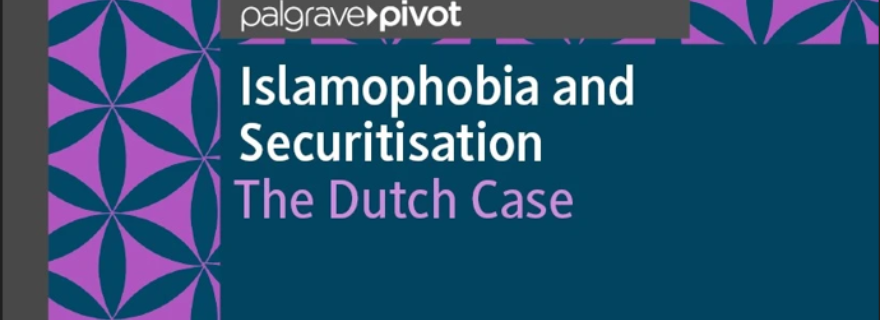Islamophobia and Securitisation: Assessing Counter-Terrorism Policy in the Netherlands
Liselotte Welten and Tahir Abbas’ recent publication examines the nature and impact of Dutch counter-terrorism and counter-extremism policies and practices concerning Dutch Muslim communities. This blog goes over some of the significant problems raised by the findings within the Palgrave-Pivot book.
Academics, government officials, and members of society in the Netherlands have all expressed a strong interest in the radicalisation of Muslims. The unmistakable sense is that the problem is large and that the actions required to tackle it are time-sensitive. This, in general, contradicts the realities on the ground, on which this book is focused. The book raises concerns regarding the nature of radicalisation and, more especially, ‘radical Salafism’ as viewed and disputed by the state and various media discourses as a consequence of our original research, which was based on interviews with thirty major Muslim players across the Netherlands. These issues have an impact on how questions of identity and belonging are portrayed, raising worries about securitisation. This book helps readers comprehend the social and political context in which radicalisation, or, more accurately, ‘radical Salafism,’ arises.
Due to various post-war migration policies as well as racial and racialisation issues, Dutch Muslim communities have endured various forms of discrimination and exclusion that persist to this day. There is also evidence of Islamophobia, which emerges with worries about discrimination, orientalism, and racialisation and affects the group’s notions of identity, belonging, and citizenship. Moroccan, Turkish, and South Asian-origin Dutch Muslims are specifically examined. It is also claimed that the ‘war on terror’ fostered Islamophobia, which persists to this day as a result of the persistent influence of securitisation of Dutch Muslim communities.
While much attention is placed on the importance of ideology as a driving force in radicalisation, issues of social exclusion, marginalisation, and discrimination are frequently overlooked. While not all people who confront downward socioeconomic mobility mixed with bad socialisation engage in violent extremism as a means of atonement, almost all of those who are eventually implicated in issues of radicalisation come from these backgrounds. While disadvantage is not a causal element, these are important contextual factors that are rarely addressed in counter-violent extremism policy and practice. The way radicalisation is conceived, understood, and operationalised to better understand and appreciate the specific Dutch Muslim experience in this field leads to complications due to misunderstanding and misrecognition, largely as a result of deflection and deviation from what are often genuine social policy concerns confronting particular communities at the sharp end of economic and social inequality.
According to respondents, the problematic relationship between traditional media/social media and public political figures stems from the hostile rhetoric about the Muslim community emanating from the politicised media, where the exchange between public political figures and the media is adjusted to the public’s interpretation and opinions. The interviews show that the public image of major political personalities allows Dutch Muslim communities to be publicly demonised.
Notable right-wing politicians Geert Wilders and Thierry Baudet’s political campaigns and overt remarks against the Dutch Muslim population highlight the Islamophobic language used to acquire electoral support. The anti-Muslim language of prominent leaders gives a picture-perfect platform for ‘radical Salafists’ to make their social justice appeals. The chapter also examines the ramifications of ‘discourse realism’ in Dutch culture, in which public figures are praised for breaking the taboo of being too soft-spoken about the apparent failure of the Dutch multicultural model. The chapter contends that the political understanding of the severity of Islamophobia has become distorted as a result of the analysis of discrimination reports, the development of anti-discrimination policies, and respondents’ experiences, resulting in a perceived false reality of accounts within policy formations and ineffective policy implementation. ‘Radical Salafists’ give several counter-arguments that urge members of Muslim communities to revolt against Dutch culture through the escalating intolerance of Islam splashed across the social media handles of specific important political personalities.
The gap between cultural-religious identification and Dutch social identity is wide. Some respondents saw it as the ideal conflict zone for recruiters of ‘radical Salafism’ to lure Muslim youngsters into rebelling against the mainstream Muslim community.
According to interviewees, young Muslims who radicalise are undereducated in Islamic affairs and do not often discuss religious topics. ‘Radical Salafist’ recruiters take advantage of the Muslim youth’s lack of Qur’anic understanding to promote their beliefs as the only ‘true’ reading of the Qur’an. Respondents discussed the need for Islamic education to be contextualised in the Dutch social context to avoid regressive readings of the Qur’an. According to the interviewees, the proposed answer is Qur’anic instruction in educational systems, as radical speakers attract substantial supporters among Muslim youth. However, this solution carries hazards, which have piqued the interest of several Dutch government organisations, prompting multiple inquiries into Islamic institutions. It exposes the inconsistencies in the Dutch government’s proposed measures.
With rising securitisation has come a greater ‘privatisation’ of self-policing inside Muslim communities. Mosques must choose between guiding the young individual and failing (individuals radicalise) or banning the individual and protecting their followers from a media and political frenzy, at the risk of alienating a broader set of people.
The Dutch Muslim minority has a long history of citizenship that dates back to the 1960s labour migration period. However, the apparent failure of a steady multicultural society has shown intrinsically discriminatory judgments towards Dutch Muslim populations with the settling of Muslim communities in the Netherlands. A bottom-up approach to policing has shown that community policing may effectively establish trust and produce successful policies. Although cultural capital has been identified as a potential deterrent to radicalisation, security agencies are wary of the influence foreign cultural organisations may have on Dutch democratic principles. The interpretation of Islamic principles has been viewed as a squandered opportunity to raise a generation that is both aware and resistant to radical interpretations of the Qur’an, particularly in the Dutch context. The Dutch Muslim communities’ efforts to assist vulnerable individuals have exposed a two-edged blade.


